
The Estación de Madrid-Chamartín Clara Campoamor or Madrid Chamartín is the second major railway station in Madrid, Spain. Located on the northern side of the city, it was built between 1970 and 1975, but more work was carried on into the early 1980s. It then superseded Atocha station, which is located just south of the city centre. However, as the AVE network expanded with a hub at Atocha, Chamartin again became Madrid's second station by passenger volume.

Estació de França is a major railway station in the city of Barcelona in Catalonia, Spain.

Barcelona Sants is the main railway station in Barcelona, owned by Adif, the railway infrastructure agency of Spain. It has become the most important transport hub of the city - being the centre of Rodalies de Catalunya including Barcelona suburban railway services and regional services, as well as the main inter-city station for national and international destinations. The station is named after Sants, the neighbourhood of Barcelona in which it is located. New parts of the station have recently been remodeled to accommodate the Spanish high-speed train AVE in the city, which started serving the city on 20 February 2008. There is also an adjacent international bus station bearing the same name, and a link to the Sants Estació metro station that serves the railway station.

The Abando Indalecio Prieto railway station, usually known simply as Bilbao-Abando and previously known as Estación del Norte is a terminal railway station in Bilbao, Basque Country (Spain). The name comes from Abando, the district in which the station is located, and Indalecio Prieto, who was Minister of Public Works during the Second Spanish Republic. The station serves as the terminus station for several long and medium distance services operated by Renfe as well as commuter rail services within the Bilbao metropolitan area operated by Cercanías. The station has direct access to Metro Bilbao and to the tram, as well as many local and regional bus lines. The railway station Bilbao-Concordia, operated by Renfe Feve is located in close proximity. After the construction of the high-speed line Basque Y is finished, Bilbao-Abando will serve as the western terminus, which will involve the creation of a completely new station replacing the current one.
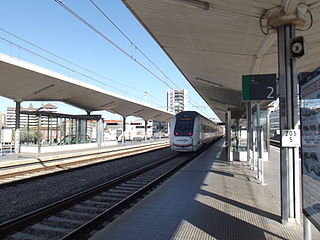
Girona is a railway station serving the city of Girona in Catalonia, Spain. It is located in the northern part of the municipality, lying at approximately 1 kilometre (0.62 mi) southwest of the city's historical centre.

Vigo railway station, also known as Vigo-Urzáiz, is a railway terminus in Vigo, Spain. It provides high speed train connection through the Atlantic Axis high-speed rail line with main Galician cities as Pontevedra, Santiago de Compostela and A Coruña every hour. The station is directly connected through the bus stop in Urzaiz street with the Airport and the Bus Station. There is a taxi stop in front of the station.
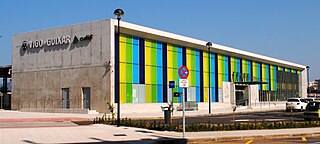
Vigo-Guixar railway station is a railway station in Vigo,, Spain. Originally the site of a freight depot for the port of Vigo, on the wharf of the same name, it serves as the temporary terminal for all trains into Vigo during the construction of the new Vialia Vigo station - replacing Vigo-Urzaiz.
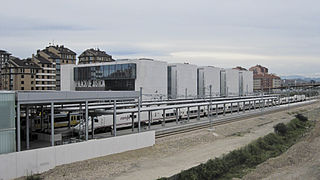
Gijón Railway Station, also known as Gijón Sanz Crespo, is the main railway station of Gijón, Spain. Since 2011 it is located in Sanz Crespo street due to the works for the Metrotrén Asturias project. It is the terminus for Alvia services from Madrid, Alicante, León, Valladolid and Barcelona, as well as Intercity and Media Distancia services from Madrid, Valladolid and León. It is also the last destination for four Cercanías commuter railway lines.

The Madrid–Galicia high-speed rail line is a high-speed railway line in Spain that links the city of Madrid with the region of Galicia via the cities of Olmedo, Zamora, Ourense and Santiago de Compostela. The line also connects the Atlantic Axis high-speed rail line to the rest of the Spanish AVE high-speed network. The Madrid–Galicia high-speed rail line is constructed as double electrified line and is designed for trains running at speeds up to 350 kilometres per hour (220 mph).
The Atlantic Axis high-speed rail line, also called Atlantic Corridor high-speed rail line, is a high-speed railway line that links A Coruña, Santiago de Compostela, Pontevedra and Vigo in Spain. The Atlantic Axis was inaugurated in April 2015.
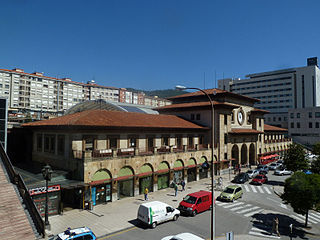
Oviedo railway station is the main station in the Spanish city of Oviedo, capital of the province of Asturias. It opened in 1874 and was reconstructed after the Spanish Civil War.
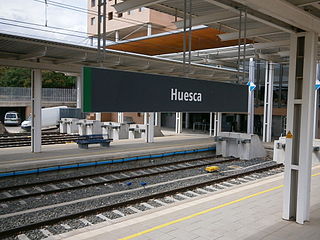
Huesca railway station serves the city of Huesca in the province of the same name, Aragon, Spain. The station is a terminus with four platforms faces and six tracks. It was opened in 2001, replacing an earlier station that had opened in 1864 along with the Zaragoza to Huesca railway. The old station was demolished not long after the opening of the new one.

Segovia-Guiomar is a central railway station of Segovia, Spain. Situated at the south of the town in the vicinity of the Hontoria Industrial Park, it has effectively replaced the old Estación de Segovia in the centre of the town, which now only serves as the terminus of the regional Line 53 from Madrid.

Antequera-Santa Ana railway station is a railway station serving the Spanish town of Antequera, Málaga in Andalusia. It is located 17 kilometres (11 mi) from the town centre, is served by the Spanish AVE high-speed rail system, on the Madrid–Málaga high-speed rail line. A gauge changer exists near the station, allowing trains to operate seamlessly on both standard gauge AVE tracks and Iberian gauge mainline tracks.

Córdoba railway station, also known as Córdoba Central is the main railway station of the Spanish city of Córdoba, Andalusia. It was opened in 1994 replacing an older station.

Santander railway station, also known as Santander ADIF to distinguish it from the Santander Feve station, is the main railway station of the Spanish city of Santander, Cantabria. It opened in 1858 and served over 3 million passengers in 2018. The station is actually a complex of two stations, one serving Renfe Iberian-gauge railways, and another adjacent serving FEVE metre-gauge services to Bilbao-Abando and Oviedo.

Ciudad Real railway station is the main railway station of the Spanish city of Ciudad Real, Castilla–La Mancha. Located on the AVE high-speed rail line from Madrid Atocha to Seville-Santa Justa and Málaga María Zambrano, travel to Madrid can be achieved in under an hour.

Cartagena railway station is the main railway station in the Spanish city of Cartagena in the Region of Murcia. It is the terminus of the Chinchilla–Cartagena railway, and the current station building opened in 1903.

Pontevedra-University is a suburban railway stop on the Redondela-Santiago de Compostela line. It is located in the municipality of Pontevedra, to the north of the city, in the autonomous community of Galicia in Spain.

The Pontevedra Bus Station is a bus station in Pontevedra (Spain) that allows inter-city bus traffic, with national or international destinations.






















